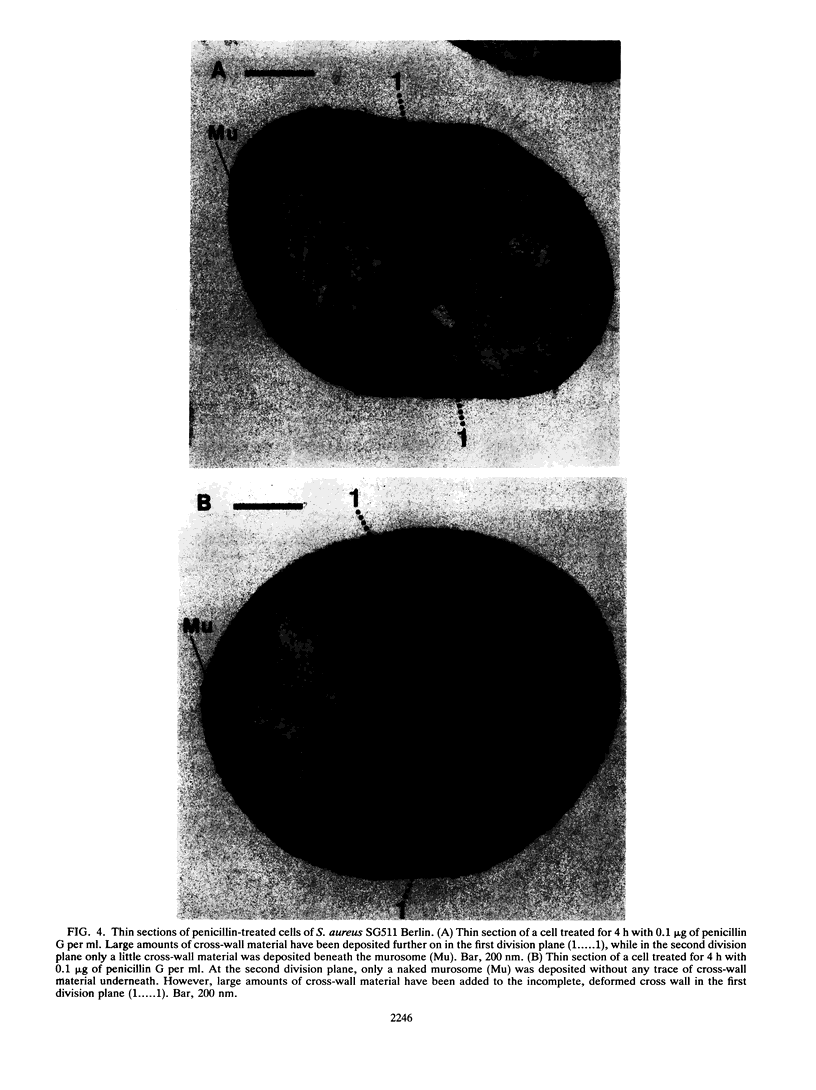Abstract
Electron microscopic research into the murosomes of staphylococci has shown that the number of murosomes involved in penicillin-induced death varies depending on the experimental conditions employed. With 0.1 micrograms of penicillin G per ml, only 1 of a total of about 20 murosomes, the "killing murosome," completely perforated the pressure-stabilized peripheral cell wall during a three-step process. This strictly localized event was mainly attributed to a mechanical effect being comparable to the process of aneurysm formation. Wall perforation was also considered to mark the very moment of penicillin-induced death ("nonlytic killing event"), while bacteriolysis started only postmortem. By varying the osmolarity of the growth medium, the number of murosomes involved in penicillin-induced killing increased considerably, which resulted in the ejection of a fan-shaped row of murosomes at the second division plane. These data are compatible with the finding that, in untreated or chloramphenicol-treated staphylococci, the activation of the murosomes resulted in (i) the formation of regularly arranged "blebs" on the cell surface, containing traces of disintegrated wall material, and (ii) the subsequent liberation of the murosomes lying underneath, leaving behind their former sites in the peripheral wall as a row of regularly arranged "pores" in every division plane. The number, distribution, and positioning of these blebs corresponded with those of the pores and the original murosomes. The significance of wall autolysins liberated from the first division plane for penicillin-induced wall perforation at the second division plane is discussed.
Full text
PDF











Images in this article
Selected References
These references are in PubMed. This may not be the complete list of references from this article.
- Amako K., Umeda A., Murata K. Arrangement of peptidoglycan in the cell wall of Staphylococcus spp. J Bacteriol. 1982 May;150(2):844–850. doi: 10.1128/jb.150.2.844-850.1982. [DOI] [PMC free article] [PubMed] [Google Scholar]
- Giesbrecht P., Labischinski H., Wecke J. A special morphogenetic wall defect and the subsequent activity of "murosomes" as the very reason for penicillin-induced bacteriolysis in staphylococci. Arch Microbiol. 1985 May;141(4):315–324. doi: 10.1007/BF00428843. [DOI] [PubMed] [Google Scholar]
- Giesbrecht P., Wecke J., Reinicke B. On the morphogenesis of the cell wall of staphylococci. Int Rev Cytol. 1976;44:225–318. doi: 10.1016/s0074-7696(08)61651-4. [DOI] [PubMed] [Google Scholar]
- Kohlrausch U., Höltje J. V. Analysis of murein and murein precursors during antibiotic-induced lysis of Escherichia coli. J Bacteriol. 1991 Jun;173(11):3425–3431. doi: 10.1128/jb.173.11.3425-3431.1991. [DOI] [PMC free article] [PubMed] [Google Scholar]
- Lorian V., Sabath L. D., Simionescu M., Watson D. W. Decrease in ribosomal density of Proteus mirabilis exposed to subinhibitory concentrations of ampicillin or cephalothin. Proc Soc Exp Biol Med. 1975 Jul;149(3):731–735. doi: 10.3181/00379727-149-38888. [DOI] [PubMed] [Google Scholar]
- Maidhof H., Johannsen L., Labischinski H., Giesbrecht P. Onset of penicillin-induced bacteriolysis in staphylococci is cell cycle dependent. J Bacteriol. 1989 Apr;171(4):2252–2257. doi: 10.1128/jb.171.4.2252-2257.1989. [DOI] [PMC free article] [PubMed] [Google Scholar]
- Reinicke B., Blümel P., Labischinski H., Giesbrecht P. Neither an enhancement of autolytic wall degradation nor an inhibition of the incorporation of cell wall material are pre-requisites for penicillin-induced bacteriolysis in staphylococci. Arch Microbiol. 1985 May;141(4):309–314. doi: 10.1007/BF00428842. [DOI] [PubMed] [Google Scholar]
- Sidow T., Johannsen L., Labischinski H. Penicillin-induced changes in the cell wall composition of Staphylococcus aureus before the onset of bacteriolysis. Arch Microbiol. 1990;154(1):73–81. doi: 10.1007/BF00249181. [DOI] [PubMed] [Google Scholar]
- Tomasz A. The mechanism of the irreversible antimicrobial effects of penicillins: how the beta-lactam antibiotics kill and lyse bacteria. Annu Rev Microbiol. 1979;33:113–137. doi: 10.1146/annurev.mi.33.100179.000553. [DOI] [PubMed] [Google Scholar]
- Tomasz A., Waks S. Mechanism of action of penicillin: triggering of the pneumococcal autolytic enzyme by inhibitors of cell wall synthesis. Proc Natl Acad Sci U S A. 1975 Oct;72(10):4162–4166. doi: 10.1073/pnas.72.10.4162. [DOI] [PMC free article] [PubMed] [Google Scholar]
- WEIDEL W., PELZER H. BAGSHAPED MACROMOLECULES--A NEW OUTLOOK ON BACTERIAL CELL WALLS. Adv Enzymol Relat Areas Mol Biol. 1964;26:193–232. doi: 10.1002/9780470122716.ch5. [DOI] [PubMed] [Google Scholar]
- Wecke J., Franz M., Giesbrecht P. Inhibition of the bacteriolytic effect of beta-lactam-antibiotics on Staphylococcus aureus by the polyanionic drugs suramin and Evans Blue. APMIS. 1990 Jan;98(1):71–81. [PubMed] [Google Scholar]
- Wecke J., Lahav M., Ginsburg I., Giesbrecht P. Cell wall degradation of Staphylococcus aureus by lysozyme. Arch Microbiol. 1982 Mar;131(2):116–123. doi: 10.1007/BF01053992. [DOI] [PubMed] [Google Scholar]
- Wecke J., Lahav M., Ginsburg I., Kwa E., Giesbrecht P. Inhibition of wall autolysis of staphylococci by sodium polyanethole sulfonate "liquoid". Arch Microbiol. 1986 Mar;144(2):110–115. doi: 10.1007/BF00414719. [DOI] [PubMed] [Google Scholar]
- Westmacott D., Perkins H. R. Effects of lysozyme on Bacillus cereus 569: rupture of chains of bacteria and enhancement of sensitivity to autolysins. J Gen Microbiol. 1979 Nov;115(1):1–11. doi: 10.1099/00221287-115-1-1. [DOI] [PubMed] [Google Scholar]









